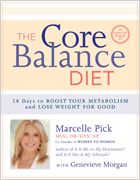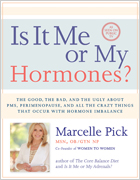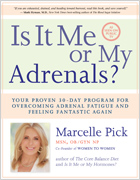By Marcelle Pick, OB/GYN NP
How core imbalances can affect your weight and health
- What’s behind The Core Balance Diet?
- Extra! Extra! Healthcare practitioner heals herself
- Fad diets are popular — but they don’t work
- Toxic weight and stress
- Determining your individual imbalance
- Clearing the path to Core Balance
Oh, the things women do to lose weight: bizarre foods, starvation diets, excessive exercise — you name it, they’ve tried it. But as a healthcare provider — and a woman who’s struggled with weight issues — I know that achieving your optimal weight is only possible when you are healthy, and your internal systems have a consistent supply of everything they need to function well. In my new book, The Core Balance Diet, I give you the blueprint for doing both.
Core balance occurs when your body, mind, and all your internal systems are able to engage in their natural, nonstop “conversation”, with information zipping efficiently back and forth between them.
When you experience core balance, your body’s communication system runs like a top and responds as necessary to input — directing your organ systems to process food, fight infection, tend to emotional needs, and perform thousands of other tasks constantly throughout your day, usually without you even noticing.
[banner id=”weight-management-system”]
Core Balance is beautiful
“Core Balance is an ideal state that occurs when your biochemistry and metabolism are functioning well, and your core physiology and emotional health are balanced. Your body easily maintains a natural, optimal weight and you feel energized, clear, and fit. Life is good, you look great, and you’re on top of the world”.
But when you have an imbalance, your glorious internal conversation is disrupted and information needed to maintain healthy function can’t get through. If the imbalance is long-term, your physical health will eventually be affected, perhaps seriously. Your appearance will reflect your imbalance and one of the most visible consequences is toxic weight — that extra weight your body holds on to, no matter what you do.
But believe it or not, this stubborn, toxic weight — which drives so many of us crazy — has a bright side. It’s a wake-up call, a signal from your body that you have an internal imbalance that needs attention, sooner rather than later. Happily, when you restore balance, often just by tweaking your diet and lifestyle and maintaining those changes, the weight will come off for good.
What’s behind The Core Balance Diet?
So how do you develop an internal imbalance? It happens when the physical, emotional, and spiritual demands being made on you outweigh the support provided. These types of imbalance can be responsible for any number of physical symptoms and conditions, including excess weight.
Over the years, I’ve been able to identify clear patterns in patients with health and weight problems, both of which are common during menopause. At first, these issues may seem unconnected, but as I’ve dug deeper, I’ve learned that both health and weight problems can often be traced directly to core imbalances within one or more of the body’s systems.
Using scientific and experiential research, I’ve decoded the main core imbalances affecting many of my patients. But the really good news is that I’ve used the principles of functional medicine to create and prescribe effective solutions to reverse these imbalances.
And remarkably, when your imbalance is resolved and physical health is restored, that stubborn toxic weight begins to disappear, almost as an afterthought. It’s the most welcome “side effect” you’ll ever have.
Extra! Extra! Healthcare practitioner heals herself
I actually have the inside scoop on regaining core balance for health and weight loss because I’ve fought my own battle of the bulge over the years. The truth is I used to be as much as 40 pounds overweight, a number that has fluctuated over the years. Until relatively recently, I never felt I was living at my optimal healthy weight.
Even as I practiced functional medicine and embarked on the exciting and rewarding career of co-founding the Women to Women Clinic, I just couldn’t lose what amounted to about 15 pounds of toxic weight. Then a series of events — both physical and emotional — pushed me to my personal tipping point, and I gained even more weight, a frightening extra 20 pounds!
As you can read in my book, my story has a happy ending. I began to eat the right foods, and removed the ones that didn’t agree with my biochemistry. I had all the mercury-laden fillings removed from my teeth, and learned how to guard against toxins. I continued to exercise regularly, as I have my entire life, and I began to feel healthier and more in balance. But for me, the last key to losing my toxic weight was being able to face my deeply entrenched emotional issues.
When I could finally do the necessary work to heal emotionally, I was able to integrate all the aspects of myself. At last, I felt “whole” and balanced on a core level. Not only was this an incredible relief, but lo and behold — that toxic weight practically melted away, and has never come back.
I understand the urgent battle that many of my patients — and readers — have been waging with toxic weight. The true motivation for The Core Balance Diet is to provide you with practical tools to help you heal your body so you can lose your toxic weight once and for all.
Fad diets are popular — but they don’t work
If you’re reading this, you probably have intimate knowledge of popular weight loss methods andfad diets, and you know they usually aren’t effective. Most trendy diets focus on calorie-counting and rigid portion sizes. Fad diets also commonly recommend a rate of weight loss that is simply too fast to be healthy, so the results are nearly impossible to maintain.
Fad diets don’t work because they…
- Focus on weight loss instead of physical health.
- Rely on deprivation, calorie-counting, and portion restriction.
- Don’t stress the importance of physical activity.
- Promote an unhealthy rate of weight loss.
- Overlook emotional wellness.
- Fail to recommend setting up a support network.
These diets have vague or nonexistent guidelines for exercise, but they also ignore the importance of the dieter’s emotional history. This is particularly troublesome because both a woman’s toxic weight and her eating patterns can often be deeply connected to her subconscious feelings and emotional past.
If you are a regular, compulsive overeater, of course you will gain weight, but the real question is, why do you eat too much? The root cause is sometimes physiological, such as a food allergy or a serotonin deficiency. But it may also have something to do with your emotional history. I know from years of clinical and personal experience that emotional healing is necessary for healthy weight management. But it’s usually just one of a number of contributing factors, the most important of which will be restoring your core balance.
One well-proven feature of successful weight loss is that it occurs more consistently when a woman has the social support she needs to lose weight and keep it off over the long haul. In fact, losing toxic weight may be downright impossible without emotional support. Even with ample instruction, you may still need someone to help you through the rough spots.
But I think most fad diets fail because they don’t acknowledge that your extra weight accumulated for a reason — and it isn’t that you eat too much. Again, the real cause of your toxic weight may be a physical imbalance that must be resolved. Once you reverse a core imbalance and restore health, your body will finally be able to let go of the extra pounds.
Toxic weight and stress
At Women to Women, we always talk to our patients about stress — how to figure out where it’s coming from, and how to manage it. Obviously, stress affects your emotional health, but does it have anything to do with gaining and retaining weight? You bet!
When you experience stress — emotional or physical — it triggers a series of physiological reactions generated by the release of powerful chemicals, particularly cortisol, which send your body into survival mode. A surge of cortisol puts you on alert and tells your body to prepare for the emergency, in part by slowing your digestion.
But your body can’t tell the difference between real threats and other types of high level stress, so it responds to both the same way. When you stay stressed for long periods, you learn to live that way. Your body stays chronically stressed, never returning to “normal,” and you stockpile food calories as fat. To make matters worse, women often eat more during stressful times, compounding any weight problem.
Clearly, chronic stress is one of the major root causes of core imbalances. Other contributors are poor nutrition, lack of exercise, environmental toxins, emotional burdens, hormone shifts, inadequate detoxification, altered neurotransmitter status, GI issues, inflammation, and impaired adrenal function. All of these stressors interfere with your internal conversation, which causes your organ systems to go haywire. This is why healing your imbalance should be the first item on your weight-loss agenda.
Is your toxic weight a result of one of these imbalances?
Digestive
A digestive imbalance can lead directly to system-wide inflammation which in turn may be connected to insulin resistance and additional accumulation of fat tissue. Inflammation can also affect your ability to absorb nutrients properly. Digestive imbalance often plays a role in food sensitivities which can cause us to crave those same foods, and eat them in excess.
Hormonal
The food we eat influences our hormonal balance on a daily basis and can create a cyclical pattern that generates toxic weight gain. Chronic stress raises levels of key hormones, like insulin and cortisol, and can cause you to eat more and gain weight. Sometimes, even the fat on your body can alter your hormonal balance and trigger additional weight gain — a true vicious cycle which is common during perimenopause and menopause.
Adrenal
Your adrenal glands are responsible for the fight-or-flight response at the center of your survival instinct. Today, this response is activated far too often, which interferes with your body’s never-ending quest to be in balance. If high level stress continues unabated, cortisol begins to take control of your body’s physical actions which can lead to both overeating, abdominal weight gain, and more. A full 85% of the women I see in my practice suffer from adrenal fatigue by the time they reach menopause, which leads to low energy periods when women often make unhealthy food choices.
Neurotransmitter
To put it simply, your individual brain chemistry can cause you to gain weight and prevent you from losing it. Neurotransmitters carry information that influences feelings — including mood, hunger, satiety (feeling satisfied), and cravings. A neurotransmitter imbalance is another condition that can cause you to crave certain foods, and eat them obsessively.
Inflammation
Inflammation is necessary as a short-term immune response for healing wounds and countering infection. It’s an essential, sometimes life-saving function of your immune system. But over-activation of this healing response — often triggered by a pro-inflammatory diet, among other things — leads to chronic inflammation. Chronic inflammation has become a major source of internal imbalance. Inflammatory imbalance can cause obesity and toxic weight gain because it can be traced directly to insulin resistance, diabetes, and metabolic syndrome.
Detoxification
A detoxification imbalance often leads to accumulation of toxins in fat tissue, which makes losing weight especially problematic. Poor nutrition and unhealthy lifestyle just magnify the problem. Some toxins can even act like hormones in the body and cause additional fat build-up.
Determining your individual imbalance
Every woman is different — physically, emotionally, intellectually, and spiritually. And we each have our own “balancing act”, a singular combination of factors influencing core health. The balls you have in the air might include your work, running a household, raising children, caring for your parents, and community service. But each woman has a combination of physical factors to balance as well, ranging from genetics and metabolism, to environmental exposure and health history — infections, surgeries, allergies, anxiety disorders, heart disease, cancer, autoimmune disorders — and all the symptoms those conditions create.
In The Core Balance Diet, I include a detailed questionnaire to help you diagram your own personal juggling act. This can help you identify which of the six major metabolic imbalances is shaping your physical health and causing you to retain toxic weight. And just so you know, it isn’t uncommon for women to suffer from more than one imbalance.
Clearing the path to Core Balance
The five T’s of Core Balance:
- Tune in to your body.
- Turn down stress.
- Treat yourself to healthy foods.
- Tune out negativity.
- Take care of mind, body, and spirit.
The brilliant silver lining behind the cloud of imbalance is that you can use it as an early warning to get on the road to regaining core balance and dropping that toxic weight. You will also be losing inches — and your shape and silhouette will reflect that beautifully!
Your first steps will be to identify the core imbalances most affecting your health, make imbalance-specific adjustments to your diet and lifestyle, and add in high-quality nutritional supplementation targeted for your imbalance.
When it comes to healing core imbalances, one size does not fit all. The Core Balance Diet offers detailed prescriptions for each imbalance, with careful instructions and guidelines for the stages of the rebalancing process. In the book, you’ll find separate food protocols for each imbalance that include easy-to-follow, day-by-day meal plans.
To help you prepare, you can start by considering these general recommendations:
- Eat natural, whole foods. Stay away from refined sugars and carbs, processed foods, additives and engineered ingredients (high-fructose corn syrup, trans fats). The book has customized eating plans for each imbalance that are easy to follow and implement.
- Hydrate your body every day. Drink pure, filtered water, bottled mineral water or herbal teas.
- De-stress! This is a multi-step process, accomplished a little at a time. You need to be able to recognize stress before you can reduce or eliminate it. Taking a thoughtful inventory of the stressors in your life is the best place to start. Read our philosophy on making changes in your life for further guidance.
- Attend to your emotional needs. Sometimes this is the most complicated aspect of regaining core balance and health. There are suggestions in the book to help you begin what can be the most rewarding “work” you will ever do.
- Cultivate spiritual health and practice self-care. Learning more about how to identify and meet your spiritual needs can have dramatic effects on your health. Check the book for ideas about creating and practicing a self-care ritual.
- Get up and move. Start with any type of physical activity and advance toward a varied exercise routine that works for you. Exercising (even just a little) a few times a week is essential for a successful weight-loss program.
- Sleep more. Inadequate sleep is correlated with obesity and other weight issues. Plus, your body performs its most important repair and rebuilding tasks during nighttime sleep. You may have to go to bed earlier, but the extra rest can improve your core health exponentially.
The gift of Core Balance
As you consider regaining the balance in your life, remember that you can’t take care of others, do your job — or lose weight — until your body gets the support it needs to meet the demands being made of it.
Many of my patients develop core imbalances without any idea of how they happened. But with a little detective work, you can use The Core Balance Diet to help you find the pieces to the puzzle of your individual imbalance. From there, a few key changes can help tip the balance back in your favor, so you feel better, look better, and can finally lose that toxic weight.
For me, staying in balance is a matter of checking in with my “four corners” — physically, emotionally, intellectually, and spiritually. And I practice my self-care ritual regularly, no matter what. Remember, there is only one you and it’s important to celebrate your individuality every day— no matter what you weigh.
 Iodine deficiency — how common is it?
Iodine deficiency — how common is it? As we learn more about how iodine functions in the body, research is revealing connections between diet, environment, and the rise of thyroid, breast, and immune health problems in women. Maybe you’ve had recent thyroid testing that came back borderline, or you’ve been diagnosed with hypothyroidism (inadequate production of thyroid hormones), and you’re already on thyroid medication. Perhaps you have fibrocystic breast condition and avoid salt by choice or due to high blood pressure. If so, it’s possible you could benefit from more insight into your iodine status and available testing and treatment options.
As we learn more about how iodine functions in the body, research is revealing connections between diet, environment, and the rise of thyroid, breast, and immune health problems in women. Maybe you’ve had recent thyroid testing that came back borderline, or you’ve been diagnosed with hypothyroidism (inadequate production of thyroid hormones), and you’re already on thyroid medication. Perhaps you have fibrocystic breast condition and avoid salt by choice or due to high blood pressure. If so, it’s possible you could benefit from more insight into your iodine status and available testing and treatment options. As recently as 2004, the New England Journal of Medicine defined our iodine status here in the US as “marginal,” based on data acquired from the International Council for the Control of Iodine Deficiency Disorder and the World Health Organization (WHO). More specifically, the WHO data suggest the greater risk in the US is not iodine deficiency per se, but iodine-induced hyperthyroidism (overproduction of thyroid hormones) or iodine-induced hypothyroidism. Interestingly, both these problems can occur when people who are already iodine-deficient are given too much iodine, too quickly. I believe practitioners need to proceed more cautiously when prescribing iodine supplements, slowly bringing levels up rather than overloading right up front. (More on our treatment protocol for iodine deficiency below). But the WHO perspective seems to confirm that iodine deficiency does exist here in the US.
As recently as 2004, the New England Journal of Medicine defined our iodine status here in the US as “marginal,” based on data acquired from the International Council for the Control of Iodine Deficiency Disorder and the World Health Organization (WHO). More specifically, the WHO data suggest the greater risk in the US is not iodine deficiency per se, but iodine-induced hyperthyroidism (overproduction of thyroid hormones) or iodine-induced hypothyroidism. Interestingly, both these problems can occur when people who are already iodine-deficient are given too much iodine, too quickly. I believe practitioners need to proceed more cautiously when prescribing iodine supplements, slowly bringing levels up rather than overloading right up front. (More on our treatment protocol for iodine deficiency below). But the WHO perspective seems to confirm that iodine deficiency does exist here in the US.




